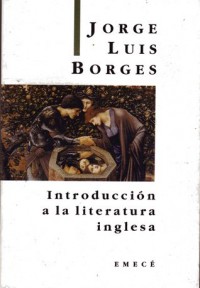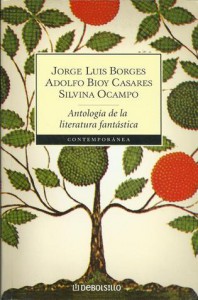Currently reading
Fluency
 Romantic sci-fi, who'd have said?
Romantic sci-fi, who'd have said?Awesome character development, pretty decent sci-fi content. The start of a brilliant career? Can't wait for the next book in the series.
Decipher
 Written like a sci-fi movie, Dan Brown style. No character development, all drones. Mingled with a million 2012 end-of-the-world crackpot theories. Nice if you like that kind of thing, Holywood movies are full of the same thing... and does a very good work on the suspense/thriller angle.
Written like a sci-fi movie, Dan Brown style. No character development, all drones. Mingled with a million 2012 end-of-the-world crackpot theories. Nice if you like that kind of thing, Holywood movies are full of the same thing... and does a very good work on the suspense/thriller angle.
Introducción a la literatura inglesa

Escrita en colaboración con María Esther Vázquez, "Introducción a la literatura inglesa" se ocupa de una de las literaturas más ricas del mundo occidental. redactada atendiendo al criterio de buscar autores o las obras más representativas de cada época y guiada por el propósito esencial de "interesar al lector y estimular su curiosidad para un estudio más profundo", la obra presenta a los principales autores ingleses y sus obras según el personal criterio del maestroa argentino.
Literaturas germánicas medievales

Escrita en colaboración con María Esther Vázquez, esta obra de Jorge Luis Borges reconstruye los orígenes de tres literaturas (escandinava, alemana y de la Inglaterra sajona) alejadas entre sí en virtud de complejas vicisitudes históricas, pero surgidas de una raíz común: el territorio que Tácito denominó Germania, menos una región geográfica que un conjunto de tribus cuyos hábitos, lenguas, tradiciones y mitologías eran afines. Dado lo remoto y casi desconocido de su materia, Literaturas Germánicas Medievales es no sólo una historia, sino también una suerte de antología para todo aquel que quiera asomarse a la vigorosa y áspera belleza de estos antiguos cantares nórdicos.
"Dado lo remoto y casi lo desconocido de su materia, no solo es una historia sino una suerte de antología. Conviene no olvidar, sin embargo, que la poesia es dificilmente traducible; ninguna version moderna puede ofrecer del todo el auténtico y antiguo sabor de los textos originales. Las lenguas germánicas, ricas en grupos consonanticos, propendían a la belleza áspera de lo épico, no a la tranquila dulzura de la lírica. Quienes lean las sagas verán prefigurada en ellas la novela moderna; quienes estudien la poesía sajona y, mas aun, la escáldica, descubrirán, descubrirán extraños y barrocos ejemplos de la metáfora."
Romantic Atheism: Poetry and Freethought, 1780-1830

Romantic Atheism explores the links between English Romantic poetry and the first burst of outspoken atheism in Britain, from the 1780s onwards. Martin Priestman examines the work of Blake, Coleridge, Wordsworth, Shelley, Byron and Keats in their most intellectually radical periods, establishing the depth of their engagement with such discourses, and in some cases their active participation. Equal attention is given to less canonical writers: such poet-intellectuals as Erasmus Darwin, Sir William Jones, Richard Payne Knight and Anna Laetitia Barbauld, and controversialists including Holbach, Volney, Paine, Priestley Godwin, Richard Carlile and Eliza Sharples (these last two in particular representing the close links between punishably outspoken atheism and radical working-class politics). Above all, the book conveys the excitement of Romantic atheism, whose dramatic appeals to new developments in politics, science and comparative mythology lend it a protean energy which belies common and more recent conception of 'loss of faith'.
The Getaway Car: A Practical Memoir About Writing and Life (Kindle Single)

“The journey from the head to the hand is perilous and lined with bodies. It is the road on which nearly everyone who wants to write—and many of the people who do write—get lost.”So writes Ann Patchett in "The Getaway Car", a wry, wisdom-packed memoir of her life as a writer. Here, for the first time, one of America’s most celebrated authors ("State of Wonder", "Bel Canto", "Truth and Beauty"), talks at length about her literary career—the highs and the lows—and shares advice on the craft and art of writing. In this fascinating look at the development of a novelist, we meet Patchett’s mentors (Allan Gurganas, Grace Paley, Russell Banks), see where she made wrong turns (poetry), and learn how she gets the pages written (an unromantic process of pure hard work). Woven through engaging anecdotes from Patchett’s life are lessons about writing that offer an inside peek into the storytelling process and provide a blueprint for anyone wanting to give writing a serious try. The bestselling author gives pointers on everything from finding ideas to constructing a plot to combating writer’s block. More than that, she conveys the joys and rewards of a life spent reading and writing. “What I like about the job of being a novelist, and at the same time what I find so exhausting about it, is that it’s the closest thing to being God that you’re ever going to get,” she writes. “All of the decisions are yours. You decide when the sun comes up. You decide who gets to fall in love...”In this Byliner Original by the new digital publisher Byliner, "The Getaway Car" is a delightful autobiography-cum-user’s guide that appeals to both inspiring writers and anyone who loves a great story.
Russian Literature: A Very Short Introduction

Review
"It is written in a lively and stimulating manner...and displays a range to which few of Dr. Kelly's peers in the field of Russian scholarship are equal."--Dr. Philip Cavendish
About the Author
Catriona Kelly is a Fellow of New College, Oxford, and the author of A History of Russian Women's Writing and co-editor of Russian Cultural Studies, both published by OUP.
The Oxford Essential Guide to Writing (Essential Resource Library) (Essential Resource Library)

This essential resource helps all writers organize, shape, and complete their work while expressing their ideas creatively and clearly. Rules of style and technique are covered, with examples of expert prose from the masters. An Appendix covers punctuation and grammar.
Inside of a Dog: What Dogs See, Smell, and Know

SUMMARY:
What do dogs know? How do they think? The answers will surprise and delight you as Alexandra Horowitz, a cognitive scientist, explains how dogs perceive their daily worlds, each other, and that other quirky animal, the human.Inside of a Dog is a fresh look at the world of dogs -- from the dog's point of view. As a dog owner, Horowitz is naturally curious to learn what her dog thinks about and knows. And as a scientist, she is intent on understanding the minds of animals who cannot speak for themselves.In clear, crisp prose, Horowitz introduces the reader to dogs' perceptual and cognitive abilities and then draws a picture of what it might be like to be a dog. What's it like to be able to smell not just every bit of open food in the house but also to smell sadness in humans or even the passage of time? How does a tiny dog manage to play successfully with a Great Dane? What is it like to hear the bodily vibrations of insects or the hum of a fluorescent light? Why must a person on a bicycle be chased? What's it like to use your mouth as a hand? In short, what is it like for a dog to experience life from two feet off the ground, amidst the smells of the sidewalk, gazing at our ankles or knees?Inside of a Dog explains these things and much more. The answers can be surprising -- once we set aside our natural inclination to anthropomorphize dogs. Inside of a Dog also contains up-to-the-minute research -- on dogs' detection of disease, the secrets of their tails, and their skill at reading our attention -- that Horowitz puts into useful context. Although not a formal training guide, Inside of a Dog has practical application for dog lovers interested in understanding why their dogs do what they do.The relationship between dogs and humans is arguably the most fascinating animal-human bond because dogs evolved from wild creatures to become our companions, an adaptation that changed their bodies, brains, and behavior. Yet dogs always remain animals, familiar but mysterious. With a light touch and the weight of science behind her, Alexandra Horowitz examines the animal we think we know best but may actually understand the least. This book is as close as you can get to knowing about dogs without being a dog yourself.







